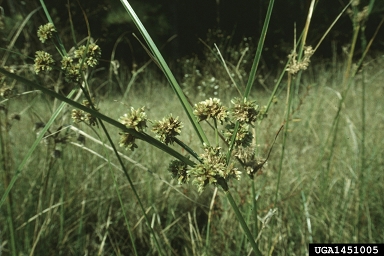Sign up for the iWire to get breaking news, event info and the species spotlight.
Go Back | Printer Friendly Fact Sheet
NOTE:
Cyperus entrerianus
Deep-rooted sedge
Synonym(s):
Family: Cyperaceae (Sedge Family)
Duration and Habit: Perennial Grass/Grasslike

Photographer: Richard Carter
Source: Valdosta State University, Bugwood.org
Description
Grows in robust, loose clumps to up to 40 inches high; leaves are cross-sectionally V-shaped and glossy. Leaf bases are distinctly purplish-black. Culms (stems) are strongly 3-sided. The inflorescence is terminal and consists of 5 - 11 groups of densely clustered spikelets, which are greenish-white. Culms are connected by thick rhizomes.
Native Lookalikes: Currently no information available here yet, or there are no native Texas species that could be confused with Deep-rooted sedge.
Ecological Threat: Rapidly spreading from disturbed to natural areas. Once established, it outcompetes native grasses and sedges, threatening local plant biodiversity. Alters habitat for the endangered Attwater's prairie chicken. A potential pest to rice agriculture.
Biology & Spread: An aggressive seed producer; large plants can produce 1 million viable seeds/year. Seeds are readily transported by water. Will flower and fruit from June through November. Also reproduces vegetatively via fragmentation and budding of rhizomes.
History: Most likely introduced via rice agriculture and was first reported in Texas from Cameron County about 20 miles north of Brownsville in 1941 (Rosen et. al, 2006). Continues to spread especially along roadsides via mowing, flooding, and soil and equipment movement.
U.S. Habitat: Thrives in disturbed, inundated soils. Will form monospecific stands in ditches, coastal prairies, low flatwoods, and fallow rice fields. Tolerant to various soil textures (sands to clays).
Distribution
U.S. Nativity: Introduced to U.S.
Native Origin: South America
U.S. Present: AL, FL, GA, LA, MS, TX
Distribution in Texas: Gulf-Coastal Texas. Established in all surrounding Galveston Bay counties, as far south as San Patricio County; and north through the eastern Piney Woods and Blackland Prairie ecoregions.
Mapping
Invaders of Texas Map: Cyperus entrerianus
EDDMapS: Cyperus entrerianus
USDA Plants Texas County Map: Cyperus entrerianus
Invaders of Texas Observations
List All Observations of Cyperus entrerianus reported by Citizen Scientists
Native Alternatives
Alternatives include:
Big bluestem (Andropogon gerardii)
Sideoats grama (Bouteloua curtipendula)
Starrush whitetop (Rhynchospora colorata)
Management
Mechanical Mowing at 2-4 week intervals suppresses seed production. Machinery should be kept clean to prevent seed spread.
Chemical: A collaborative study between USDA-ARS, USGS-FCSC and USFWS show 2% solution of Glyphosate is expected to achieve 98% control when applied at a rate of 2 quarts/acre.
Text References
Rosen, D.J., R. Carter and C.T. Bryson. 2006. The spread of Cyperus entrerianus (Cyperaceae) in the southeastern United States and its invasive potential in bottomland hardwood forests. Southeastern Naturalist 5:333-344. http://www.valdosta.edu/~rcarter/Rosen.Carter.Bryson.2006.pdf
Online Resources
The Quiet Invasion: A Guide to Invasive Plants of the Galveston Bay Area.
https://www.invasive.org/eastern/other/ypentrflyer.pdf
Search Online
Google Search: Cyperus entrerianus
Google Images: Cyperus entrerianus
NatureServe Explorer: Cyperus entrerianus
USDA Plants: Cyperus entrerianus
Invasive Plant Atlas of the United States: Cyperus entrerianus
Bugwood Network Images: Cyperus entrerianus











